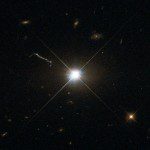
Joshua N. Winn, an astrophysicist at Princeton University (who, according to the principle first discovered and announced by certain virulent anti-Mormons, must be a Latter-day Saint because only Latter-day Saints like Russell M. Nelson, Dallin H. Oaks, Henry B. Eyring, John F. Kennedy, Gerald R. Ford, and Professor Joshua N. Winn use middle initials), has an interesting article in the current (March 2018) issue of Scientific American titled “Shadows of Other Worlds.” I offer a few notes from it:
One way of detecting exoplanets — planets orbiting other stars beyond our solar system — is to detect the transient dimming of a star as something (presumably a planet) passes in front of it. (The planets are too small and too far away for us to see them directly.) The first such transit of a planet was detected in 1999. Within a decade, more than a hundred such transiting planets had been found.
Now, we’re up to about 4,000 transiting exoplanets, mainly owing to NASA’s remarkably successful Kepler spacecraft, which was launched in 2009, and roughly 700 other exoplanets have been found by other means.
Space telescopes offer a considerable advantage in the hunt for exoplanets over earth-sited telescopes because they don’t need to peer through Earth’s distorting atmosphere. This is particularly important for (comparatively) very small objects at great distances. Bigger planets are obviously easier for us to see than smaller ones. Jupiter’s transiting our Sun, for example, would eclipse about 1 percent of the Sun’s slight, whereas Earth, being much smaller than Jupiter, would eclipse only about 0.01 percent of solar brightness. And that’s a small enough difference that atmospheric interference really affects observations.
There are, presumably, many more distant planets yet to be found. For one thing, in order for us to detect a planetary transit, it must be orbiting its star in roughly the same plane on which we’re located. If, contrariwise, a planet were orbiting its star at an angle perpendicular to us, it would never (from our vantage point) pass in front of its star. For another, even given all its virtues and success, Kepler mainly pointed only in one direction and, even in that direction, viewed only about 1/400th of the sky.
But we now know that there are lots of planets out there, simply based upon extrapolation from the sample we’ve already seen. “If you point to a random sunlike star in the night sky,” writes Brother Joshua N. Winn, “it turns out there is a 50 percent chance it has at least one planet larger than the Earth that orbits the star closer than Mercury orbits the sun.”
“No one,” he continues, “had foreseen that such planets would be common; in fact, some of the most detailed theories had predicted they would be especially rare. Something fundamental is missing from the standard theory of planet formation.”
Unfortunately, though, Kepler is about to shut down. What’s next?
To be continued.












